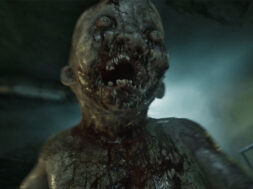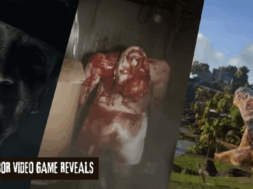Five years doesn’t compare to a decade, but for Sony’s God of War franchise, the span of time from the first game’s release in 2005, to the conclusion of the trilogy in 2010, had produced several big changes. The original God of War had little equal in terms of its unique gameplay, scale and story. Not to mention its protagonist antihero, Kratos. Fast-forward five years, and you had the likes of Nathan Drake and the first Uncharted game, Bayonetta, Dante’s Inferno and more that had not only taken elements from God of War series, but improved upon them while adding their own unique gameplay elements. And, with the move to the PlayStation 3, what could Sony do with the new hardware that would set God of War III apart from its contemporaries?
Picking up immediately where the second game leaves off, God of War III finds Kratos together with Gaia and the other Titans ascending Mount Olympus against the gods. Poseidon launches an assault against the Titans, but is killed by Kratos and Gaia, with his death causing the oceans to flood Greece. Upon reaching the peak of Olympus, Kratos and Gaia attempt to attack Zeus, but Kratos is knocked off the mountain. Betrayed by Gaia, who refers to Kratos as nothing more than a pawn for the Titans’ revenge, Kratos falls into the River Styx. Losing his weapons and greatly weakened, Kratos is instructed by the spirit of Athena to extinguish the Flame of Olympus to kill Zeus, save mankind and exact his revenge.

Being on the PlayStation 3, expectations with high for GoW III from every standpoint. Luckily, the team at the Santa Monica studios were up for the task. Right from the start, scaling up Mount Olympus while fighting Poseidon and the Hyppocampi was unlike anything you saw in the previous games (which is something when you look at some of the boss fights from GoW II). The sheer scale of the fight combined with the camera work and controls set players up for something special.
In case you didn’t realize it, the graphics are still something to behold, ten years on. Olympia still remains beautifully bright, while Hades’ shadows and fire flicker and glow ominously. And of course, there’s the gore. You can’t talk about GoW III without mentioning the plethora of plasma flung around. There’s a bit of a perverse delight in seeing Centaurs’ intestines spill out, or Gorgons being gutted along their bodies before their heads are ripped off. One could say that some of the gore treads that fine line of mean-spiritedness, but it looks all so good…

Of course, all the graphical goodness would mean nothing if you couldn’t control Kratos, now would it? As the old adage says, if it’s not broken, why bother fixing it? The series was already known for having one of the best control schemes for any action game at the time, so it’s no wonder that the Santa Monica team didn’t mess with them. On top of the attack combos that are easily performed with simple combinations of the face buttons, switching weapons can be done using a tap of the D-pad or L2 trigger. Platforming is still relatively easy with the Icarus wings, with the ability to glide over longer distances making things feel safer. The flight sequence is still a bit of an irritation, but not to the point of frustration.
GoW III retains the puzzles found in the previous entries, but they’re never too difficult or frustrating. Santa Monica again put the effort needed into their design, which resulted in the puzzles never coming across as padding to lengthen the game. They’re all cleverly designed, with the Garden of Hera and the Palace of Hades being standouts. Quick-time events are back again as well, and while personally I’ve never seen the point for some of them (such as the QTEs during cinematics), they still make logical sense when you think of their implementation. Tying things all together is the outstanding score by Gerard Marino, Ron Fish, Mike Reagan, Jeff Rona, and Cris Velasco. The entire soundtrack explores a variety of themes, which rightly accentuates the action as much as it does the quieter moments.

If there was ever a shortcoming for GoW III, it would be the story. The story throughout the series has always been Kratos’ never-ending quest for vengeance. He’s that angry badass who slices up everyone in his path on his quest, regardless of whether they were innocent or not. People didn’t necessarily “like” Kratos as a character, but were more intrigued with just what increasingly over-the-top act of violence he’d dish out next. This is why it seems so odd that Santa Monica tried to have a redemption arc for Kratos with regards to Pandora. The idea that Pandora reminds Kratos of his daughter is one thing, but up until the point, Kratos has always been that shouty character who lacks even the remotest sense of a moral compass. So, why would he suddenly develop feelings for Pandora?

It’s frustrating narrative-wise, because once again, Kratos has never had a sympathetic side at any point in the series. No work has been done prior in the previous games to humanize him outside of repeated flashbacks to his murder of his wife and child. To be fair, you could argue that Ares did something to that effect by tricking Kratos into killing his family. Or the fact that Kratos now carries that reminder with him. But when Pandora has her speech about hope, and even later, when she sacrifices herself, we’re suddenly confronted with a humanized Kratos, which feels like something out of an entirely different game.
But, if you’re like most fans, you were probably able to overlook this slight in favour of the absolute blast God of War III was, and still very much is. The fact that Sony put out a remastered version of the game on the PS4, which subsequently became part of the PlayStation Hits line, proves the staying power of the game. Ridiculously violent and beautiful at the same time, combined with amazing gameplay, God of War III is still worthwhile to revisit to see where Kratos came from.










